If you’re looking for an adorable and low-maintenance fish to add to your aquarium, Otocinclus Catfish might be the perfect choice. These little fish are known for their algae-eating abilities and peaceful nature, making them a great addition to any community tank. However, caring for Otocinclus Catfish requires some knowledge and effort to ensure they thrive in their environment.
Otocinclus catfish require a well-maintained aquarium with suitable water conditions, a varied diet, and a peaceful environment. They need a pH range of 6.5-7.5 and a temperature range between 72-78°F. The aquarium should be planted, and regular water changes should be performed to ensure their health. They are peaceful and social fish, making them a popular choice for community tanks.
In this ultimate care guide, I will share everything you need to know about caring for Otocinclus Catfish, from setting up their tank to feeding and breeding them. Whether you’re a beginner or an experienced fish keeper, you’ll find valuable tips and advice to keep your Otocinclus Catfish healthy and happy.
Throughout this article, we’ll cover topics such as the ideal tank setup, water parameters, diet, and common health issues to watch out for. By the end of this guide, you’ll have all the information you need to create a thriving environment for your Otocinclus Catfish and enjoy their company for years to come.
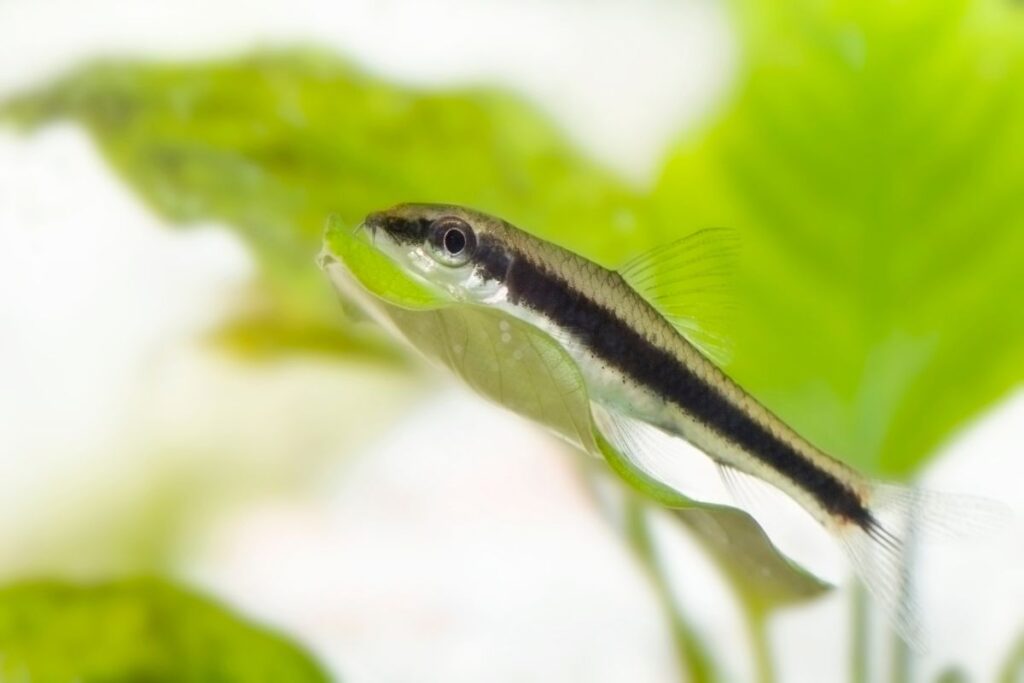
Table of Contents
Key Takeaways
- Otocinclus catfish are peaceful, social fish that should be kept in groups of at least 6 in a tank that is at least 20 gallons in size.
- Provide hiding places and decorations in the tank, such as plants or rocks, to create a stimulating environment for your otocinclus catfish.
- Maintain a proper filtration system to keep the water clean and healthy for your otocinclus catfish.
- Feed your otocinclus catfish a balanced diet of algae wafers, fresh vegetables, and occasional live or frozen foods.
- Keep the water temperature between 72-78°F and the pH level between 6.5-7.5 for optimal otocinclus catfish health.
- Monitor the water quality regularly, and perform partial water changes every week to maintain good water quality.
- Avoid overcrowding the tank and keep only compatible fish species together.
- Observe your otocinclus catfish daily for any signs of illness or abnormal behavior, and seek veterinary care if necessary.
- Handle your otocinclus catfish with care and avoid sudden movements or changes in their environment.
- Otocinclus catfish can live up to 5 years with proper care, so be prepared for a long-term commitment.
Species Summary
As a proud owner of Otocinclus Catfish, I can attest to the fact that they are amazing aquarium fish that are easy to care for.
In this section, we will provide a brief overview of the species, including their origin, appearance, size, growth rate, lifespan, behavior, and temperament.
Origin
Otocinclus Catfish, also known as dwarf suckers, are native to South America, specifically the Amazon River basin.
They are commonly found in slow-moving streams, creeks, and rivers with sandy or muddy bottoms.
Appearance
Otocinclus Catfish are small, slender fish that typically grow to be around 1-2 inches in length.
They have a light brownish or olive-green body with a white or cream-colored underside. They also have a distinctive black stripe that runs from their eye to their tail.
Size
As mentioned earlier, Otocinclus Catfish typically grow to be around 1-2 inches in length.
They are considered to be one of the smaller species of catfish, making them a great addition to smaller aquariums.
Growth Rate
Otocinclus Catfish are relatively slow growers, and it can take several months for them to reach their full size.
However, with proper care and a healthy diet, they can grow to be quite robust and healthy.
Lifespan
Otocinclus Catfish can live for several years in a well-maintained aquarium.
With proper care, they can live for up to 5 years, making them a great long-term addition to any aquarium.
Behavior & Temperament
Otocinclus Catfish are peaceful and social creatures that are known for their playful and active behavior.
They are also great at cleaning up algae and other debris in the aquarium, making them a valuable addition to any aquarium ecosystem.
Overall, Otocinclus Catfish are a great choice for any aquarium enthusiast looking for a low-maintenance, easy-to-care-for fish.
With their playful behavior and helpful cleaning habits, they are sure to bring joy and entertainment to any aquarium.
Tank Setup
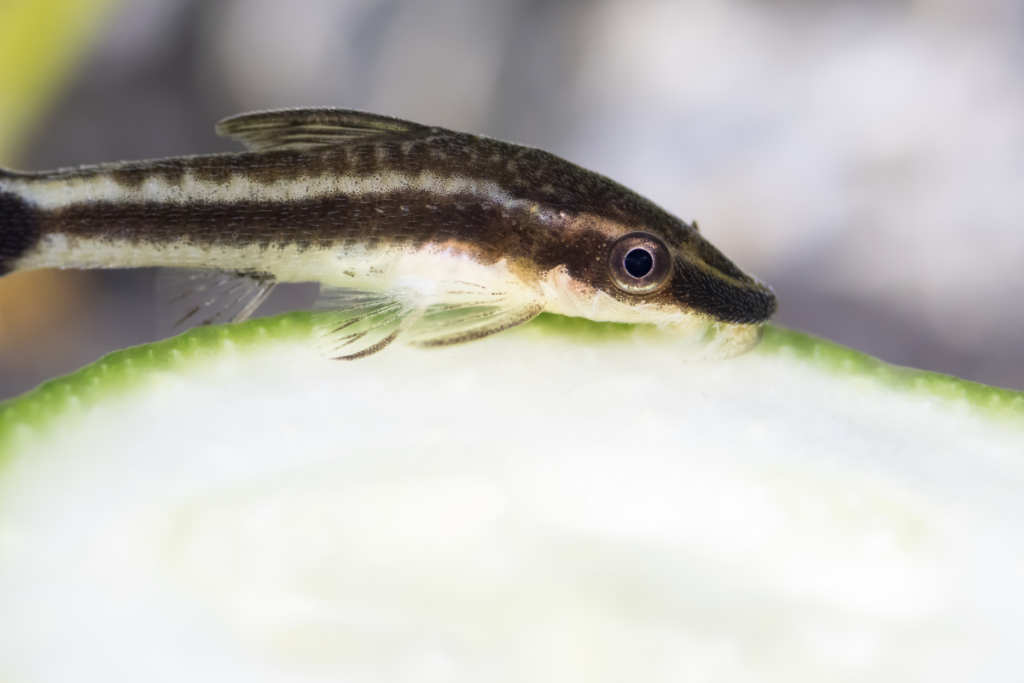
Tank Size
| Tank Size | Number of Otocinclus Catfish | Water Volume | Water Change Frequency |
|---|---|---|---|
| 20 gallons | 6 or more | 20 gallons | 25% every week |
| 30 gallons | 10 or more | 30 gallons | 25% every week |
| 40 gallons | 15 or more | 40 gallons | 25% every week |
| 50 gallons | 20 or more | 50 gallons | 25% every week |
When it comes to Otocinclus Catfish, the bigger the tank, the better. I recommend a minimum tank size of 20 gallons for a small group of Otocinclus.
This will provide them with enough space to swim around and explore.
Lighting
While Otocinclus Catfish do not require any special lighting, it is important to provide them with a consistent day/night cycle.
A timer can be used to ensure that the lighting is consistent and mimics their natural environment.
Filtration
A good filtration system is crucial for the health of your Otocinclus Catfish.
A hang-on-back filter or canister filter is recommended, as they provide excellent mechanical and biological filtration. Make sure to clean the filter regularly to prevent any buildup of waste.
Aeration
Air pumps and airstones are not necessary for Otocinclus Catfish, as they obtain oxygen through their gills.
However, a gentle flow of water from the filter can help to oxygenate the tank.
Heater
Otocinclus Catfish are tropical fish and require a consistent water temperature of around 75-80°F.
A heater can be used to maintain the temperature, but make sure to monitor it regularly to avoid any fluctuations.
Substrate
A fine sand or gravel substrate is ideal for Otocinclus Catfish, as it mimics their natural habitat.
Avoid using sharp or rough substrates, as they can damage the delicate barbels on their mouths.
Plants
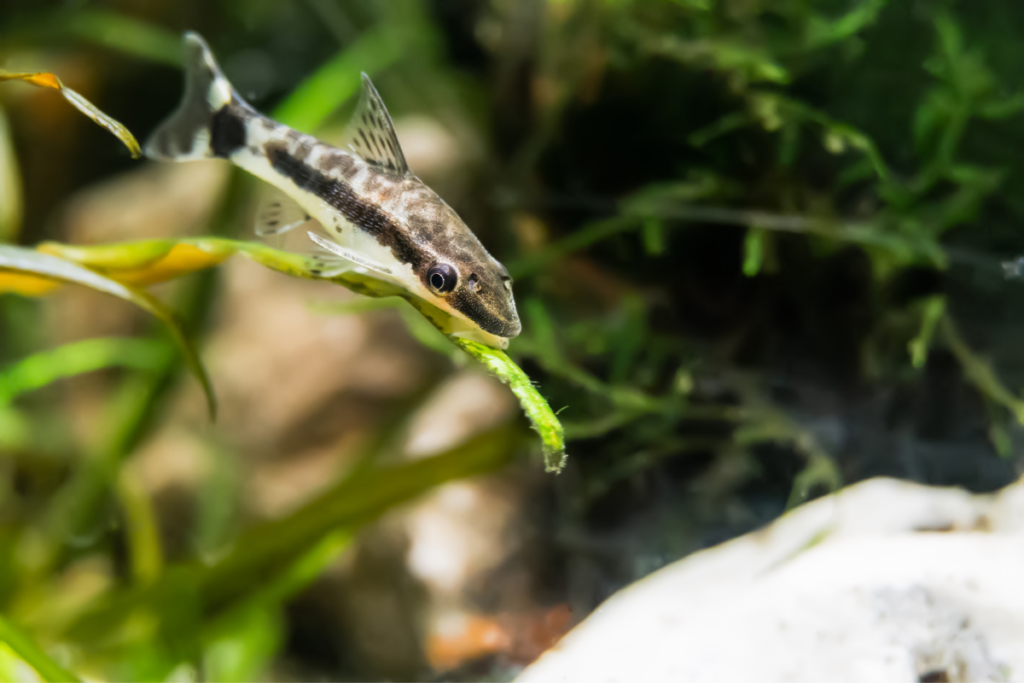
Otocinclus Catfish enjoy having plants in their tank, as it provides them with hiding places and grazing surfaces.
Live plants are recommended, as they help to maintain water quality and provide oxygen.
Decoration
| Decoration Type | Benefits |
|---|---|
| Plants | Provide hiding places and a natural environment |
| Rocks and caves | Provide hiding places and a stimulating environment |
| Driftwood | Provide a natural substrate for the tank |
Decorations such as rocks, driftwood, and caves can provide hiding places for your Otocinclus Catfish.
However, make sure that the decorations are smooth and do not have any sharp edges that could harm your fish.
Overall, setting up a tank for Otocinclus Catfish requires some attention to detail, but it is well worth it to provide a healthy and happy home for your fish.
Personally, I have found that Otocinclus Catfish thrive in a tank with plenty of plants and hiding places.
I like to use driftwood and smooth river rocks to create a natural-looking environment.
With the right setup, these little fish can bring a lot of joy to your aquarium.
Water Conditions
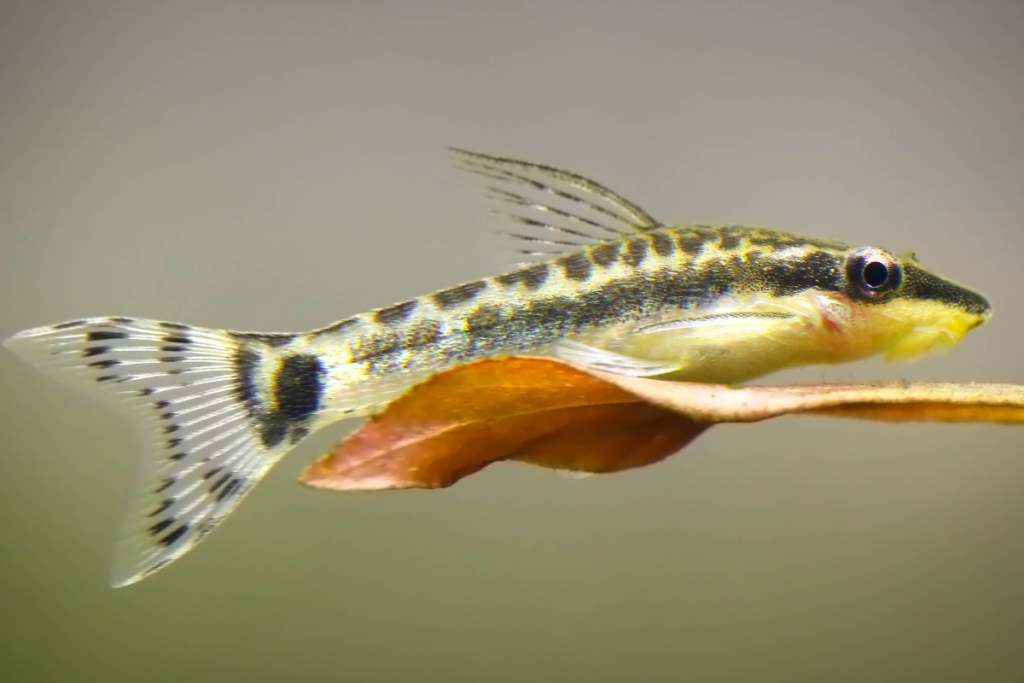
Temperature
The optimal temperature for Otocinclus Catfish is between 72°F and 78°F. It is important to maintain a stable temperature within this range to avoid stressing the fish.
Rapid temperature changes can be harmful to the fish and can lead to illness or death.
pH and Hardness
The pH level of the water should be between 6.8 and 7.5, and the water hardness should be between 2 and 12 dKH. Soft water is preferred, but the fish can adapt to slightly harder water conditions.
It is important to monitor the pH and hardness levels regularly and make adjustments as necessary to maintain a stable environment for the fish.
Water Changes
Regular water changes are crucial for the health of Otocinclus Catfish. Aim to change 25% of the water in the tank every two weeks.
This will help to remove any accumulated waste and toxins from the water. When performing water changes, make sure to treat the new water with a dechlorinator before adding it to the tank.
Personally, I have found that maintaining stable water conditions is key to keeping my Otocinclus Catfish healthy and happy.
I always use a thermometer to ensure the water temperature is within the optimal range, and I test the pH and hardness levels regularly.
Additionally, I perform water changes every two weeks to keep the water clean and fresh. By following these simple steps, I have been able to provide the best care for my Otocinclus Catfish.
Tank Mates for Otocinclus
| Fish Species | Compatibility |
|---|---|
| Corydoras | Compatible with otocinclus catfish |
| Neon tetras | Compatible with otocinclus catfish |
| Guppies | Compatible with otocinclus catfish |
| Harlequin rasboras | Compatible with otocinclus catfish |
If you are planning to keep Otocinclus catfish in your aquarium, you need to carefully consider their tank mates. Otocinclus are peaceful fish and can be easily intimidated by aggressive or larger fish.
Here are some great tank mates for Otocinclus catfish:
- Neon Tetras: These small and peaceful fish are a great match for Otocinclus. They are both peaceful and can coexist in the same aquarium without any issues.
- Corydoras Catfish: These bottom-dwelling fish are also peaceful and can be great companions for Otocinclus. They have similar dietary needs and will not compete for food.
- Cherry Shrimp: These tiny and colorful shrimp can be a great addition to your aquarium. They are peaceful and will not harm Otocinclus. However, make sure to provide enough hiding spots for the shrimp as Otocinclus may occasionally snack on them.
While Otocinclus can coexist with many other peaceful fish, it is important to avoid aggressive or larger fish.
They can easily stress out Otocinclus and make them more susceptible to diseases.
Additionally, avoid keeping Otocinclus with fish that have a similar body shape, such as Plecos, as they may mistake them for competitors and fight for territory.
Personally, I have had great success keeping Otocinclus with Neon Tetras and Cherry Shrimp.
They have been great companions and have added a lot of color and activity to my aquarium.
However, I have learned to always keep an eye on the aquarium and make sure that everyone is getting along.
How Many Otocinclus Should Be Kept Together?
When it comes to Otocinclus catfish, it’s important to keep them in groups rather than alone.
They are social creatures and thrive when kept in groups of six or more. Keeping them in groups also helps to reduce stress and aggression among the fish.
When selecting your Otocinclus, it’s important to consider the size of your tank.
A general rule of thumb is to have one gallon of water per inch of fish, but for Otocinclus, it’s recommended to have at least 10 gallons of water for a group of six.
This will provide enough space for them to swim and explore, as well as ensure that the water quality remains stable.
It’s also important to note that Otocinclus are peaceful fish and should not be kept with larger, aggressive fish. They are best kept with other small, peaceful fish such as tetras, guppies, and rasboras.
Personally, I have six Otocinclus in my 20-gallon tank, along with a school of neon tetras. They all get along great and it’s fascinating to watch them interact with each other.
I’ve found that keeping them in a group has made them more active and playful, which is a joy to watch.
Feeding
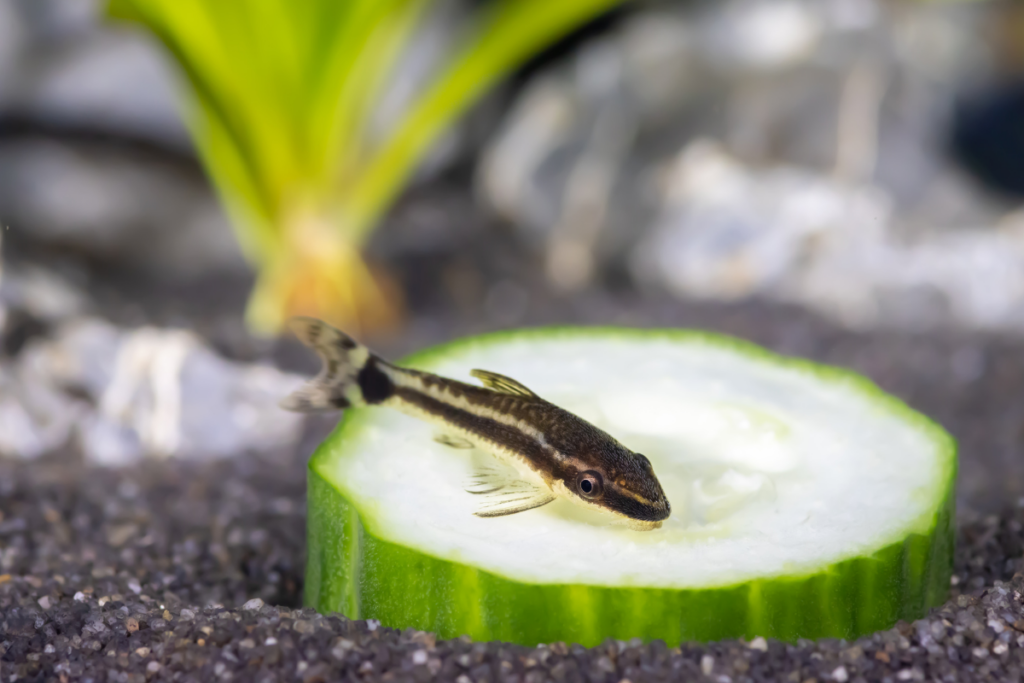
Feeding your Otocinclus catfish is an essential part of their care. In this section, we will discuss the ideal diet and feeding schedule for these little fish.
Diet
| Food Type | Frequency |
|---|---|
| Algae wafers | Daily |
| Fresh vegetables | Twice a week |
| Live or frozen foods | Once a week |
Otocinclus catfish are primarily herbivores, and their diet should reflect this. They love to eat algae, so make sure your tank has plenty of it.
You can also supplement their diet with fresh vegetables such as zucchini, cucumber, and spinach.
Make sure to blanch the vegetables before feeding them to your catfish, as this makes them easier to digest.
Another great food for Otocinclus catfish is sinking pellets or wafers. Look for high-quality pellets that are specifically formulated for herbivorous fish.
These pellets will provide your catfish with all the necessary nutrients they need to stay healthy and happy.
Feeding Schedule
When it comes to feeding your Otocinclus catfish, it’s important to establish a regular feeding schedule. These fish are small and have high metabolisms, so they need to eat several times a day.
I personally feed my Otocinclus catfish twice a day, once in the morning and once in the evening.
I give them a small amount of sinking pellets or wafers each time, and they usually finish it within a few minutes.
It’s important not to overfeed your catfish, as this can lead to health problems.
Only give them as much food as they can eat in a few minutes, and remove any uneaten food from the tank.
Overall, feeding your Otocinclus catfish is easy and straightforward.
By providing them with a balanced diet and establishing a regular feeding schedule, you can ensure that they stay healthy and happy for years to come.
Health
Common Diseases
Otocinclus Catfish are generally hardy fish, but like all living creatures, they can fall ill.
One of the most common diseases that Otocinclus Catfish can suffer from is Ich, also known as White Spot Disease.
This disease is caused by a parasite that attaches itself to the fish’s skin and fins, causing small white spots to appear.
Other common diseases include bacterial infections, fungal infections, and parasitic infections.
Prevention
The best way to prevent diseases in Otocinclus Catfish is to maintain a clean and healthy aquarium.
Make sure that the water is well-filtered, and perform regular water changes to keep the water quality high.
Additionally, avoid overcrowding the tank, as this can lead to stress and increased susceptibility to diseases.
Finally, quarantine any new fish before adding them to your tank to prevent the spread of disease.
Treatment
If you notice any signs of illness in your Otocinclus Catfish, it’s important to act quickly.
The first step is to isolate the sick fish in a separate tank to prevent the spread of disease.
Depending on the type of disease, treatment options may include medication, salt baths, or raising the water temperature.
Be sure to research the specific disease and treatment options before administering any medication to your fish.
Personally, I once had an Otocinclus Catfish that developed a fungal infection.
I quickly isolated the fish and treated it with medication, but unfortunately, it did not survive.
This experience taught me the importance of monitoring your fish’s health closely and acting quickly if you notice any signs of illness.
Signs of a Healthy Otocinclus

As an aquarium enthusiast, I have learned that keeping fish healthy requires a keen eye and attention to detail. Otocinclus Catfish are no exception. Here are some signs that your Otocinclus is healthy:
- Active and Alert: A healthy Otocinclus is active and alert. It should be swimming around and exploring its environment. If it is lethargic or hiding, it may be a sign of illness.
- Healthy Appetite: Otocinclus are known for their voracious appetite. If your Otocinclus is not eating, it may be a sign of illness or stress.
- Clean Gills: The gills of a healthy Otocinclus should be clean and free of debris. If you notice any discoloration or mucus, it may be a sign of an infection or disease.
- Clear Eyes: The eyes of a healthy Otocinclus should be clear and bright. If you notice any cloudiness or discoloration, it may be a sign of an infection or disease.
- Smooth Skin: A healthy Otocinclus should have smooth, unblemished skin. If you notice any bumps or lesions, it may be a sign of an infection or disease.
By keeping an eye out for these signs, you can ensure that your Otocinclus is healthy and happy in its aquarium home.
Remember to perform regular water changes and maintain a clean environment to prevent illness and disease.
Signs of a Sick Otocinclus
| Symptom | Possible Cause |
|---|---|
| Lethargy | Poor water quality, disease |
| Loss of appetite | Poor water quality, disease |
| White spots on body | Ich or other parasitic infection |
| Red or inflamed gills | Bacterial or fungal infection |
| Cloudy eyes | Bacterial or fungal infection |
If you have an Otocinclus catfish, it is essential to be able to recognize the signs of a sick fish. Here are some of the most common signs that your Otocinclus may be ill:
- Loss of appetite
- Lethargy or sluggishness
- Clamped fins
- Rapid breathing or gasping at the surface of the water
- Visible signs of injury or disease, such as white spots or red sores
- Abnormal swimming behavior, such as swimming upside down or in circles
If you notice any of these symptoms, it is important to take action quickly to try to save your fish.
One of the first things you should do is check the water parameters in your tank to make sure they are within the appropriate range for Otocinclus catfish.
Poor water quality can cause a variety of health problems for fish, so it is crucial to keep your tank clean and well-maintained.
Another thing you can do is observe your fish closely to see if you can identify any other potential causes of illness.
For example, if you notice that your Otocinclus is being bullied by other fish in the tank, it may be stressed and more susceptible to disease.
In this case, you may need to rearrange the decorations in your tank or add more hiding places to give your Otocinclus a safe place to retreat.
Personally, I once had an Otocinclus that became sick and started swimming erratically.
I quickly realized that the water in my tank was too warm, which was causing stress for my fish.
I lowered the temperature and added some aquarium salt to the water to help my Otocinclus recover. Within a few days, my fish was back to its normal, active self.
Breeding
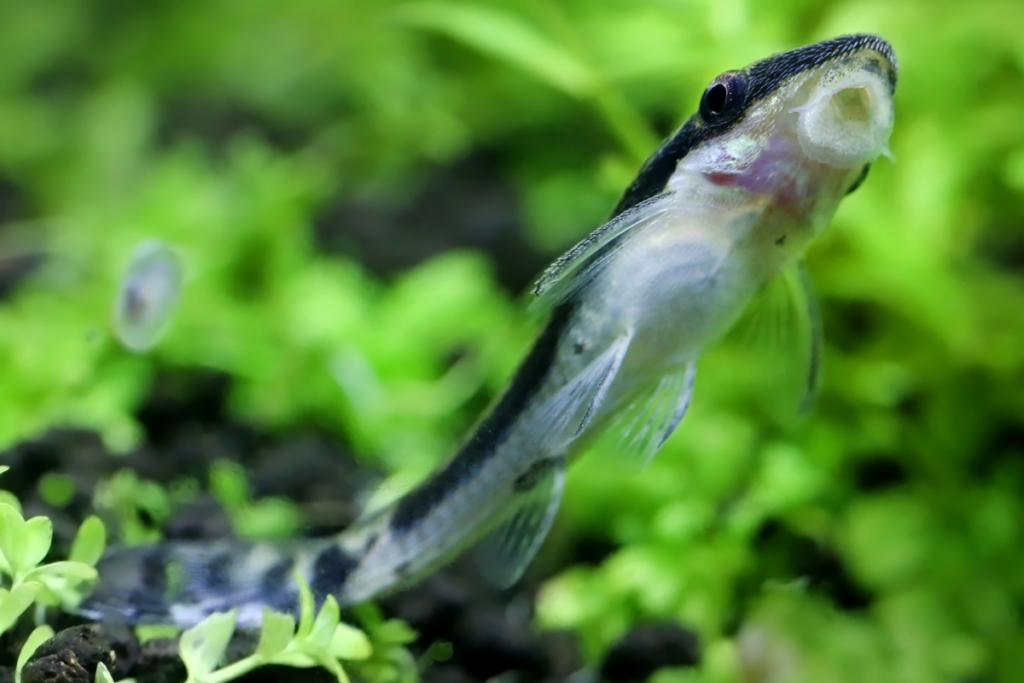
Breeding Otocinclus Catfish is a rewarding experience that requires proper preparation and care. Here’s what you need to know to successfully breed your Otocinclus Catfish.
Breeding Setup
To set up a breeding tank, you’ll need a separate tank with the following equipment:
- Heater
- Filter
- Air pump
- Substrate
- Plants
- Caves or other hiding spots
I personally like to use a 10-gallon tank for breeding. I also add a sponge filter to keep the water clean and a heater to maintain a temperature of around 78°F.
I like to add some plants and caves to provide hiding spots for the fish.
Breeding Process
Breeding Otocinclus Catfish can be challenging, but it’s possible with the right conditions. Here’s what you need to do:
- Condition the fish: Before breeding, you need to condition the fish by feeding them high-quality food like brine shrimp or bloodworms. This will help them produce healthy eggs.
- Introduce the fish: Once the fish are conditioned, you can introduce them to the breeding tank. Make sure there’s plenty of hiding spots for the fish.
- Trigger breeding: To trigger breeding, you’ll need to mimic the rainy season by doing a large water change and lowering the water level. This will stimulate the fish to breed.
- Wait for eggs: After breeding, the female will lay eggs on the plants or other surfaces in the tank. The eggs will hatch in about 4-5 days.
- Care for fry: Once the eggs hatch, you’ll need to care for the fry by feeding them small amounts of food like powdered fish food or infusoria.
I’ve found that breeding Otocinclus Catfish can be challenging, but also very rewarding.
By providing the right conditions and care, you can successfully breed these fascinating fish.
Recommended Products:
- AquaClear Power Filter – This hang-on-back filter is a great option for a 20-gallon tank or larger. It has a multi-stage filtration system that includes mechanical, chemical, and biological filtration, and is easy to maintain and clean.
- Eheim Jager Aquarium Thermostat Heater – This aquarium heater is a great option for maintaining a stable water temperature for your Otocinclus Catfish. It has an adjustable temperature range and a shatterproof glass construction.
- CaribSea Eco-Complete Planted Aquarium Substrate – This substrate is specifically designed for planted aquariums and can provide a natural environment for your Otocinclus Catfish. It also contains nutrients that can help to promote plant growth.
- NICREW ClassicLED Plus Planted Aquarium Light – This aquarium light is a great option for providing the necessary light for your Otocinclus Catfish and plants. It has adjustable brightness and color temperature, and can be used for both freshwater and planted aquariums.
- Seachem Flourish Excel – This liquid fertilizer is a great option for promoting plant growth in your Otocinclus Catfish aquarium. It provides essential nutrients for plants and helps to prevent algae growth.
- Marina Decor Polyresin Cave – This decoration is a great option for providing hiding spots for your Otocinclus Catfish. It is made of safe and non-toxic materials, and has a realistic look.
- API Freshwater Master Test Kit – This testing kit is a great option for monitoring the water quality in your Otocinclus Catfish aquarium. It includes tests for pH, ammonia, nitrite, and nitrate, and is easy to use.
- Omega One Veggie Rounds – These sinking pellets are a great option for providing a balanced diet for your Otocinclus Catfish. They are made with high-quality ingredients and contain a variety of nutrients.
Conclusion
After reading through this ultimate care guide for Otocinclus Catfish, I hope you have gained a better understanding of how to properly care for these adorable little fish.
Remember that Otocinclus Catfish require a specific environment and diet to thrive, so it’s important to do your research before bringing them home.
Personally, I have found that Otocinclus Catfish make wonderful additions to any aquarium. Not only are they great at keeping your tank clean, but they also have unique personalities and can be quite entertaining to watch.
However, it’s important to keep in mind that they are delicate creatures and require proper care in order to live a long and healthy life.
By following the tips and guidelines outlined in this guide, you can ensure that your Otocinclus Catfish are happy and healthy for years to come.
Remember to keep their tank clean, provide them with a balanced diet, and create a suitable environment for them to thrive in.
With a little bit of effort and dedication, you can enjoy the company of these fascinating fish for many years to come.
FAQs
Here are some frequently asked questions about caring for Otocinclus Catfish:
Q: How often should I feed my Otocinclus Catfish?
A: It is recommended to feed your Otocinclus Catfish small amounts of food several times a day. They have small stomachs and can only eat a little at a time. I personally feed my Otocinclus Catfish twice a day, once in the morning and once in the evening.
Q: What type of food should I feed my Otocinclus Catfish?
A: Otocinclus Catfish are herbivores and prefer to eat algae and other plant-based foods. You can feed them algae wafers, blanched vegetables like zucchini or cucumber, or even spirulina flakes. I have found that my Otocinclus Catfish love fresh spinach leaves.
Q: Can Otocinclus Catfish live with other fish?
A: Yes, Otocinclus Catfish are peaceful fish and can live with other non-aggressive fish. They are great tank mates for tetras, guppies, and other small fish. However, it is important to note that they can be sensitive to water conditions, so make sure to keep the tank clean and well-maintained.
Q: How often should I clean my Otocinclus Catfish’s tank?
A: It is recommended to do a partial water change of about 25% every week. In addition, you should use a gravel vacuum to clean the substrate and remove any uneaten food or waste. I have found that keeping up with regular water changes and tank maintenance has helped keep my Otocinclus Catfish healthy and happy.
Q: How can I tell if my Otocinclus Catfish is healthy?
A: A healthy Otocinclus Catfish should have clear eyes, a smooth body, and be active and alert. They should also be eating regularly and not showing any signs of stress or disease. If you notice any changes in their behavior or appearance, it is important to address the issue promptly to ensure their health and well-being.
I hope these FAQs have helped answer some of your questions about caring for Otocinclus Catfish. Remember, providing a clean and healthy environment, feeding them a balanced diet, and keeping up with regular tank maintenance are key to keeping your Otocinclus Catfish happy and thriving.
Reference: Wikipedia.
